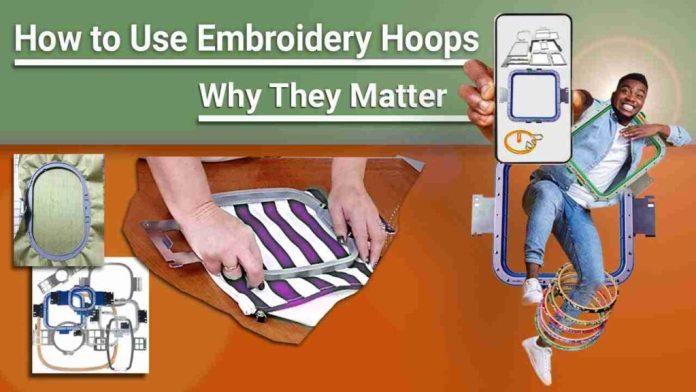Embroidery has been a cherished art form for generations, allowing creators to express themselves through intricate needlework. One of the fundamental tools in the embroidery world is the embroidery hoop. These hoops play a pivotal role in ensuring your embroidery projects turn out beautifully and professionally. In this guide, we’ll delve into the world of embroidery hoops, exploring various hoop types and sharing insights on how to make the most of them. Whether you’re a seasoned embroiderer or just starting, this guide will provide you with the knowledge you need to elevate your Embroidery digitizing game.
Introduction to Embroidery Hoops
Embroidery hoops are circular or sometimes oval, frames with an adjustable outer ring and an inner ring. They are used to hold fabric taut while you embroider, ensuring even stitching and preventing puckering. These hoops are available in various materials, sizes, and types, catering to different project needs.
The Basics of Using Embroidery Hoops
Using an embroidery hoop correctly is crucial to achieving high-quality embroidery. The process involves placing your fabric between the two rings, adjusting the tension, and then stitching your design. The hoop keeps the fabric stable and ensures your stitches are uniform throughout your project.
Different Types of Embroidery Hoops
3.1. Round Wooden Embroidery Hoops
These classic hoops are made of wood and consist of an outer and inner ring. They are versatile and great for beginners.
3.2. Oval Embroidery Hoops
Oval hoops are suitable for embroidery designs that require more length or width. They provide extra space for your stitches.
3.3. Rectangular Hoops for Stitches
Rectangular hoops are perfect for stitching along straight lines. They are favored for creating precise borders and rows of stitches.
3.4. Spring-Tension Embroidery Hoops
Spring-tension hoops have an adjustable screw that helps in maintaining fabric tension. They are ideal for delicate fabrics.
3.5. Snap Frame Hoops
Snap frame hoops are easy to use and allow you to quickly switch between different fabric pieces.
3.6. Magnetic Embroidery Hoops
Magnetic hoops use magnets to hold the fabric, making them gentle on delicate fibers and minimizing hoop marks.
How to Choose the Right Hoop for Your Project
The choice of hoop depends on your design, fabric, and personal preference. Consider factors like design size, fabric type, and the ease of handling while selecting a hoop.
Step-by-Step Guide: Using Embroidery Hoops Effectively
5.1. Preparing Your Fabric and Hoop
Start by washing and ironing your fabric. Place the inner hoop on a flat surface, lay the fabric over it, and press the outer hoop down over the fabric.
5.2. Mounting the Fabric in the Hoop
Gently tug the fabric in all directions to ensure it’s taut. Tighten the hoop’s screw or mechanism to secure the fabric in place.
5.3. Adjusting the Tension
Proper tension prevents wrinkles and distortion. Adjust the tension by slightly loosening or tightening the hoop’s mechanism.
5.4. Selecting the Right Embroidery Floss
Choose embroidery floss that complements your fabric. Separate the floss strands and use as many as needed for the desired thickness.
5.5. Starting Your Embroidery
Begin stitching from the center of your design. Use small, even stitches for a neat and professional look.
5.6. Finishing and Removing the Fabric
Once you’ve completed your embroidery, loosen the hoop’s tension and remove the fabric. Gently press your finished piece.
Embroidery Digitizing Services and Their Role
Embroidery digitizing services convert your design into a digital format that embroidery machines can understand. This process enhances accuracy and detail in your embroidery.
Advantages of Using Embroidery Digitizing Services
Digitizing services offer speed, precision, and the ability to replicate intricate designs consistently.
How Embroidery Digitizing Impacts Your Design
Digitizing can optimize the placement of stitches, thread colors, and overall design layout for a flawless outcome.
Understanding Embroidery Digitizing Techniques
Different techniques, such as fill stitches and satin stitches, are used in digitizing to create texture, depth, and visual interest.
Enhancing Your Embroidery with the Right Hoop
The right hoop improves stability during digitized embroidery, ensuring the design is executed as intended.
Common Mistakes to Avoid When Using Embroidery Hoops
Avoid improper tension, using the wrong hoop size, or pulling stitches too tightly to prevent fabric distortion.
Tips for Maintaining Your Embroidery Hoops
Keep your hoops clean, store them properly, and periodically check for any wear and tear.
Conclusion
Embroidery hoops are indispensable tools for achieving remarkable embroidery results. Understanding the different hoop types and their correct usage is key to creating beautiful needlework. Whether you’re a hobbyist or a professional embroiderer, using the right hoop and incorporating Embroidery digitizing service can elevate your creations to new heights.





